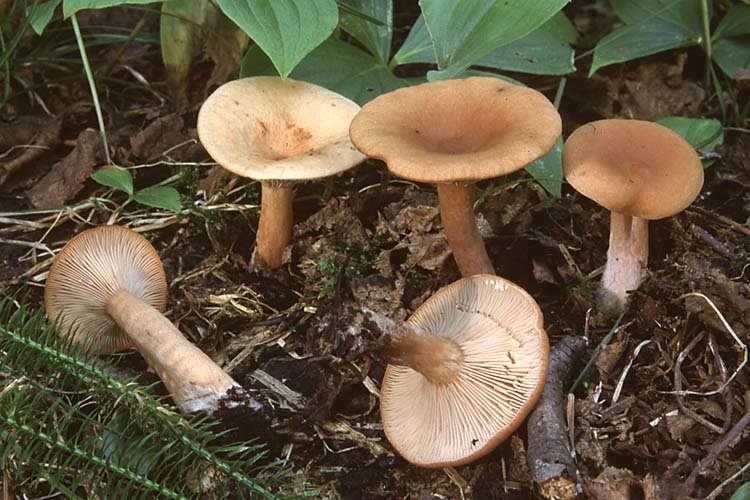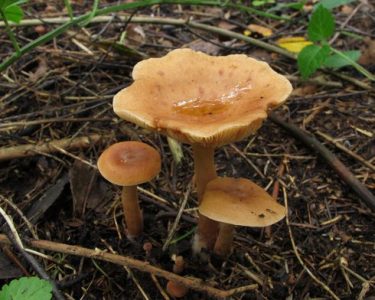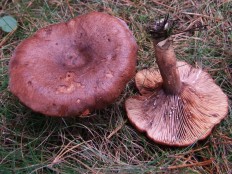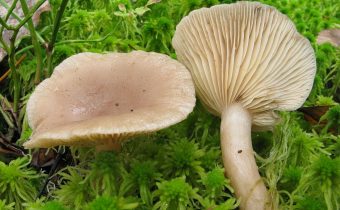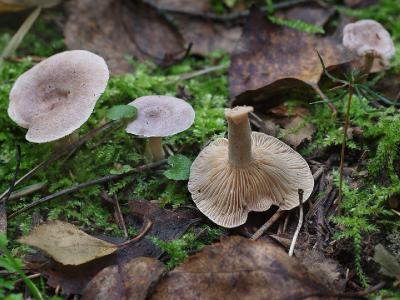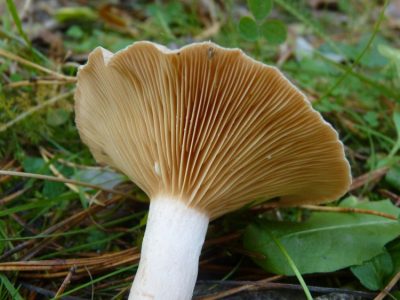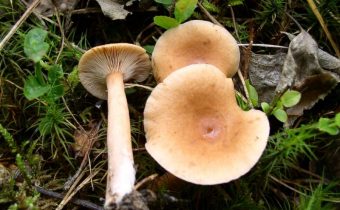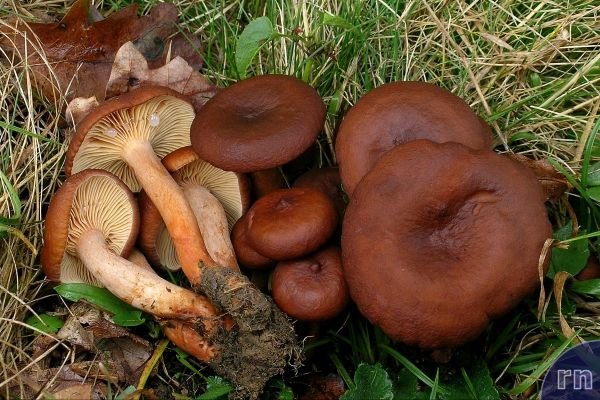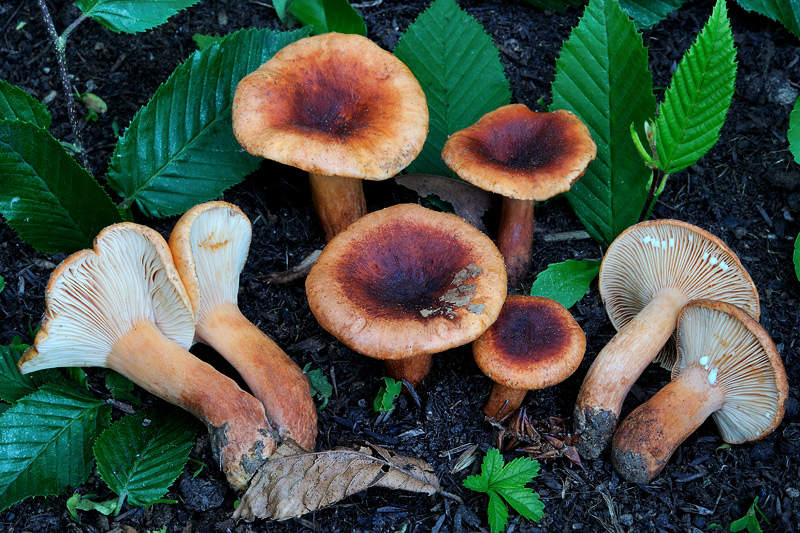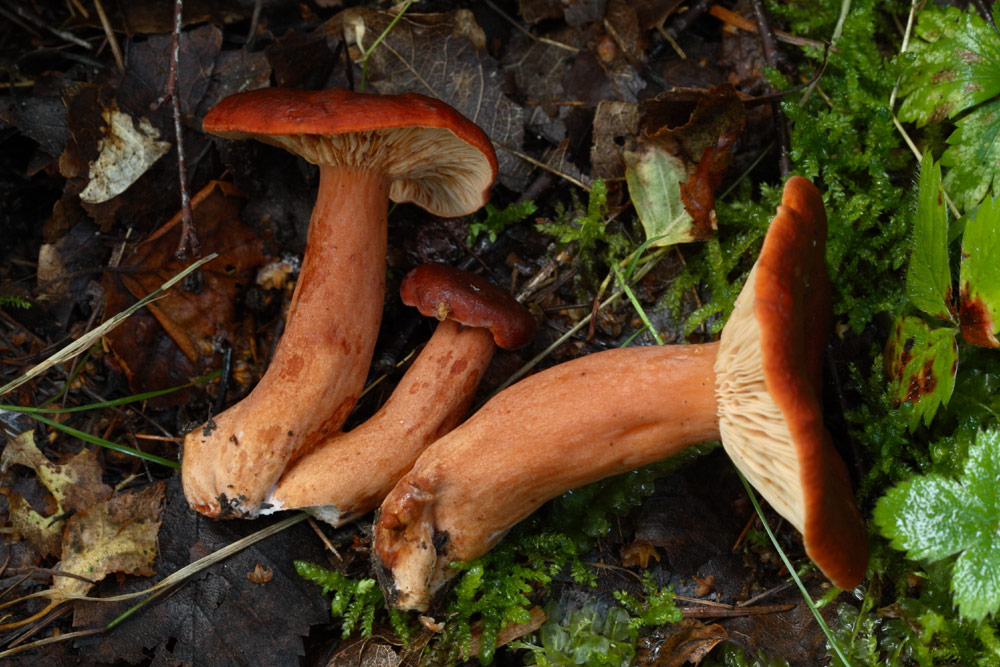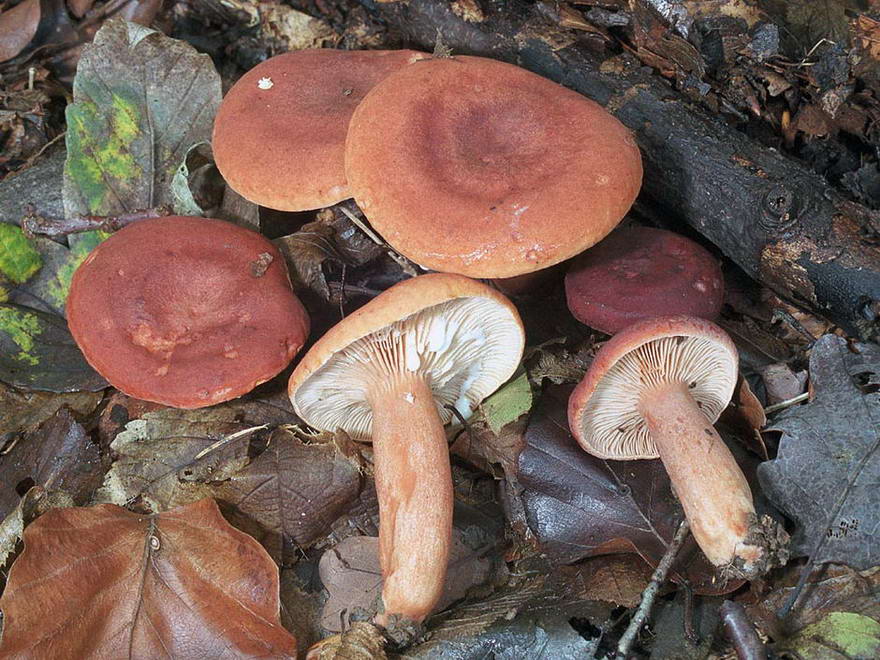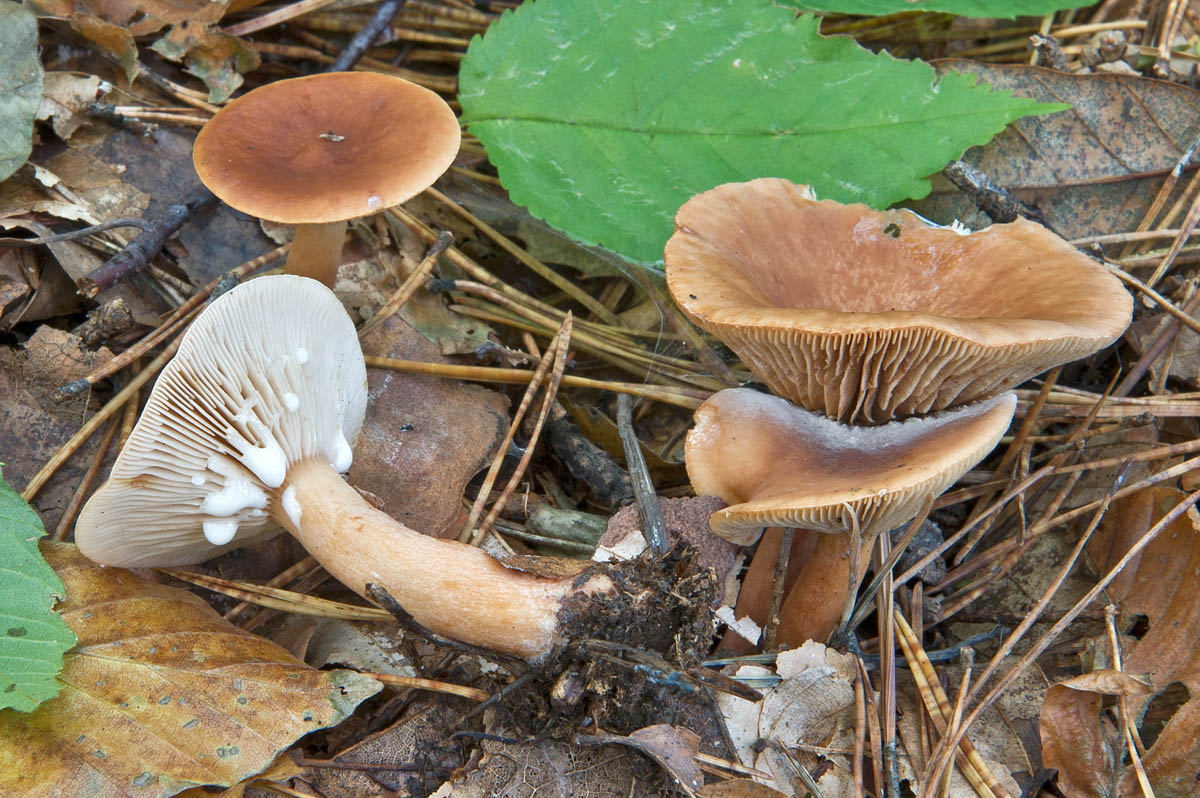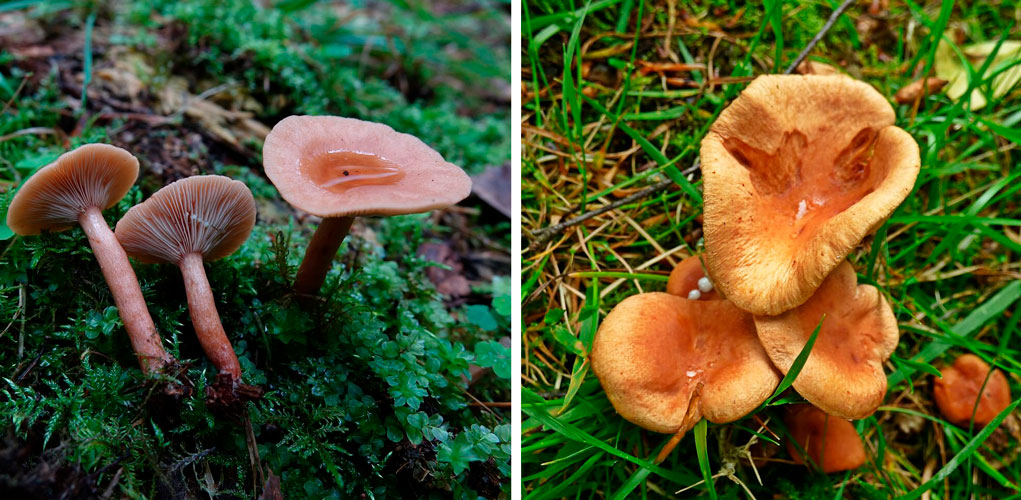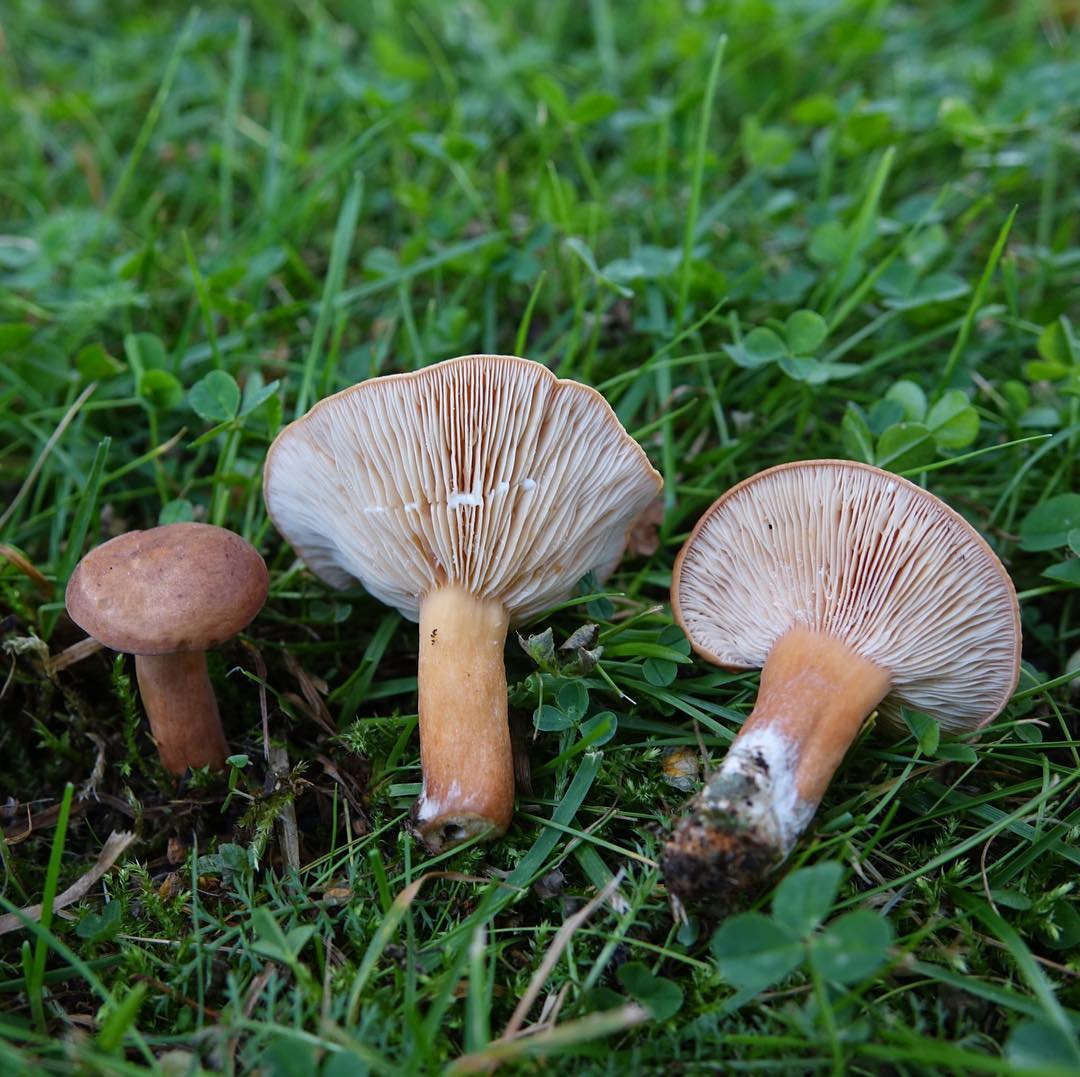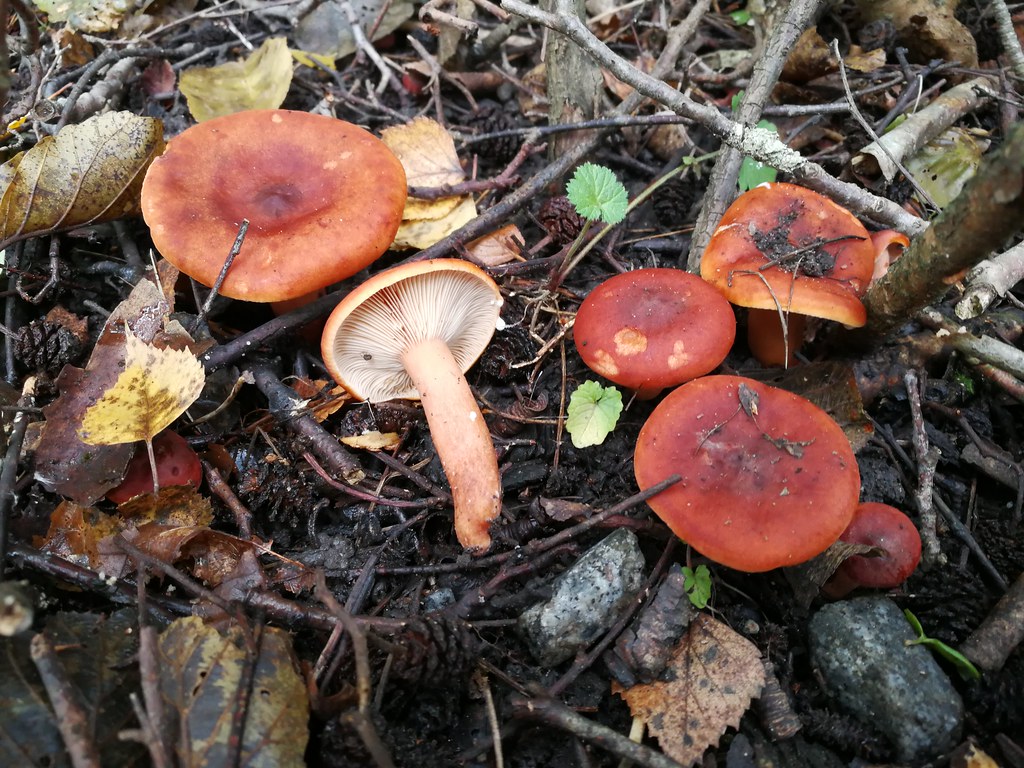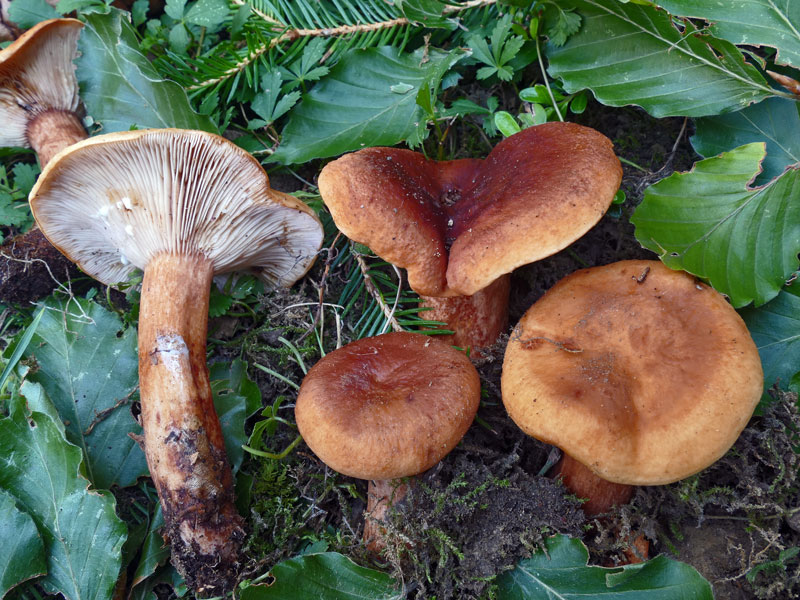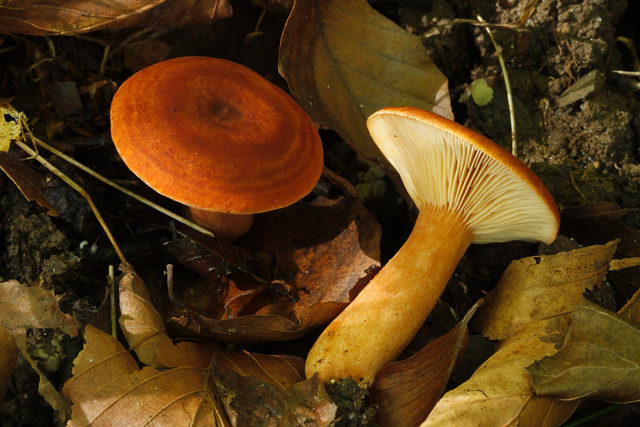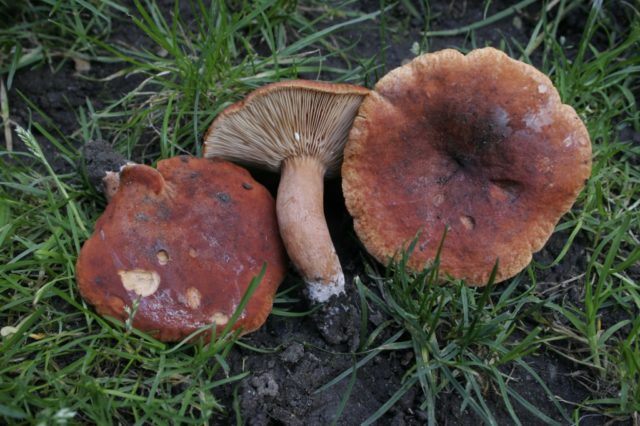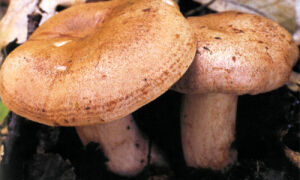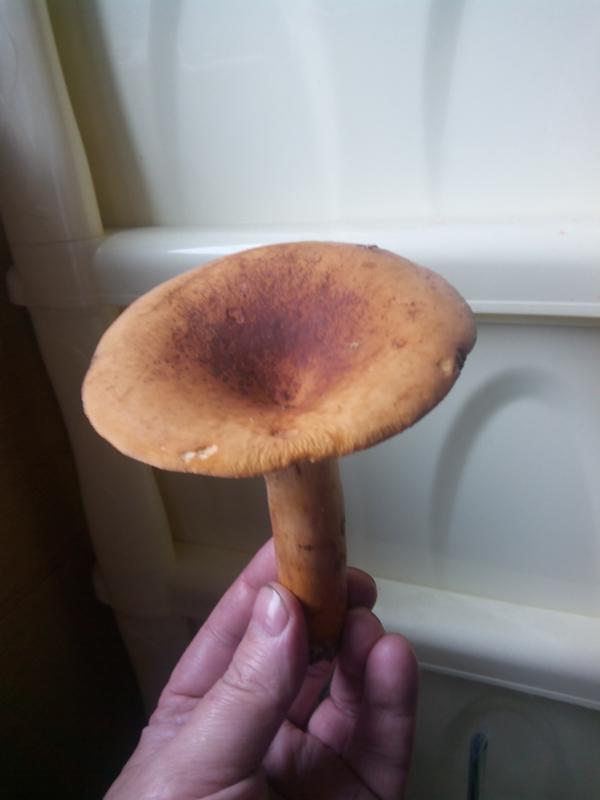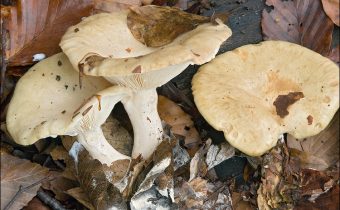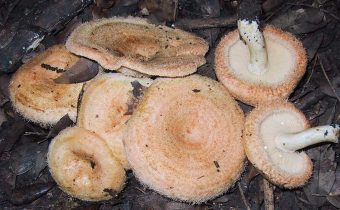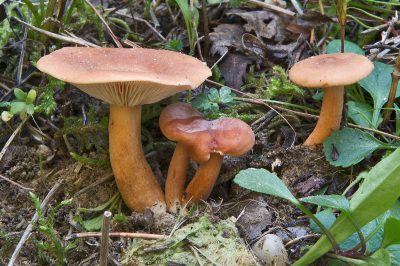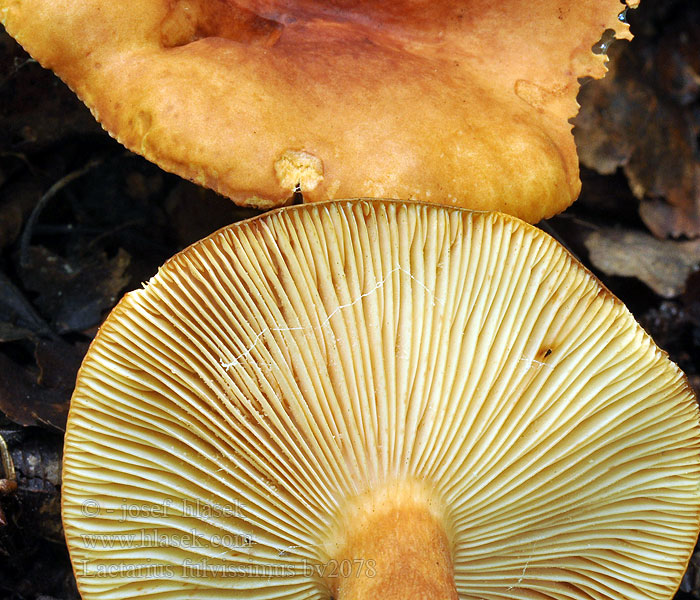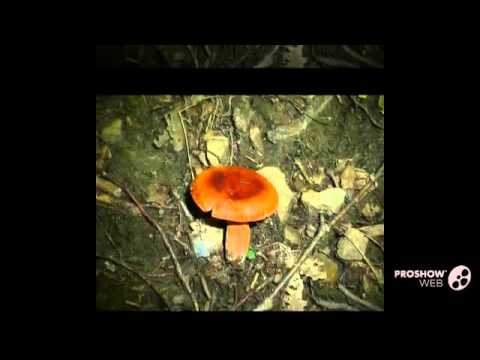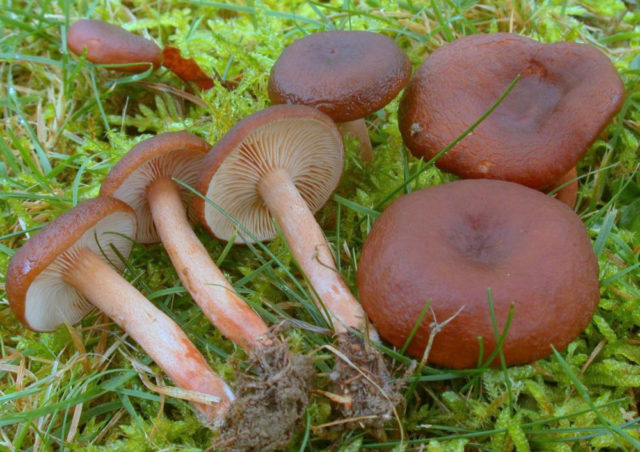Millers gooey and gray-pink
The sticky milky is conditionally edible. The cap is 5-10 cm, convex, with curled edges, later slightly depressed, with a dimple in the center, mucous when moistened, sticky in dry weather, olive, gray or brownish. The plates are white, often located, slightly descending, with drops of milky juice. Leg 5-8 cm long, 1-2 cm thick, dense, hollow, lighter than the cap. Milky juice is white, plentiful, turns olive in the air. The pulp is white, firm, with a peppery taste.
Grows in deciduous and coniferous forests.
Occurs from July to September.
The sticky milky has no poisonous counterparts.
Pre-soaking is required. Suitable for cold pickling. With prolonged cold salting of bitter and caustic milkers, lactic acid fermentation occurs, which reduces the pungency and makes it more pleasant.
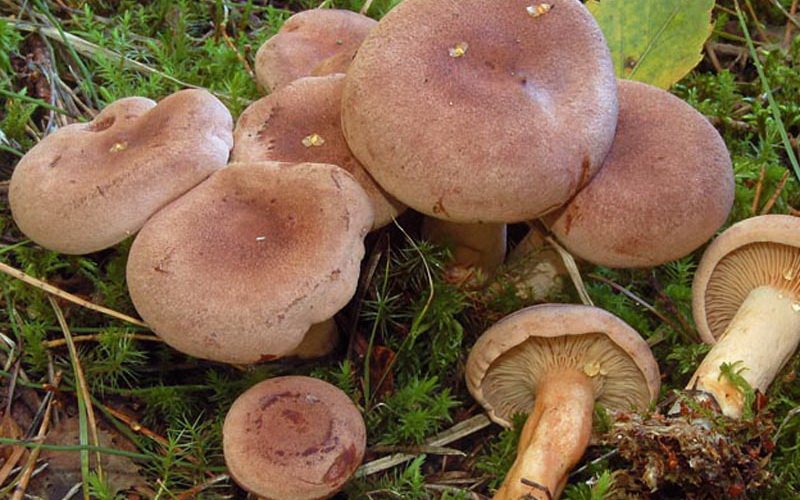
Miller gray-pink in the photo
The gray-pink milky is a rather rare, lamellar mushroom, in some reference books referred to as inedible milk mushroom or roan milky. Grows in small groups or in numerous colonies, forming bundles-intergrowths, from the second half of July to early October. As the main habitat, it prefers mossy soil in pine or mixed forests, as well as thickets of blueberries and the vicinity of swamps.
The mushroom is inedible. The cap is 10-15 cm, concave, dry, matte finely scaly, at first flat with a tucked edge, then prostrate, widely depressed, funnel-shaped with a wavy curved edge.
Pay attention to the photo - in this type of milk mushroom, the cap is gray-pink, pinkish-beige, yellowish or brownish with a darker middle without concentric zones:
The plates are brittle, narrow, descending, yellowish at first, then pink-buffy. The stem is up to 8 cm high, cylindrical, colored in the color of the cap, in old mushrooms the stem is hollow, pubescent in the lower part with mycelium. The pulp is firm, brittle, not burning pinkish-yellow or orange on a fresh cut, with a strong spicy smell of hay and dried mushrooms. Milky juice is colorless, not pungent. In certain weather, the funnels of old mushrooms and moss are covered with pink-white spore powder nearby.
Grows among mosses in pine forests with high-moor peat soil.
It has no poisonous counterparts, but it can be confused with the burning-caustic molokans.
It differs from them in colorless, not pungent juice.
Millechnik: photo and description of the genus of mushrooms. What do milkmen look like?
Millers are mushrooms with thin or thick fleshy, dense, but fragile fruit bodies, mostly medium to large in size. Their cap and stem are homogeneous (homogeneous) and do not separate from each other without breaking, as, for example, in a champignon. There are stocky mushrooms with a thick stem, approximately equal in length to the diameter of the cap (Lactarius deliciosus, Lactarius pubescens, Lactarius turpis), and there are also species in which a small cap is placed on a long, relatively thin stem (Lactarius camphoratus, Lactarius lignyotus). Fungi of this genus lack both the private and the general cover.
The cap of the lactarius can be funnel-shaped, depressed, convex-outstretched, or convex. In young mushrooms, it is straight or convex with the edge tucked down. White or brightly colored (yellow, orange, gray, pink, brown, blue, lilac, olive black), with a wavy, straight or ribbed edge. With age, some mushrooms change the color of their fruit chalk.
The surface of the lactic cap is dry or slimy, smooth, scaly, fleecy or velvety, monochromatic or with concentric circular zones and grooves - lacunae. The size of the cap is from 8 to 40 cm (Lactarius vellereus). In a stunted lactarius (Latin Lactarius tabidus) and a dark lactary (Latin Lactarius obscuratus), the cap is capable of swelling, absorbing water.
The miller is stunted.
The flower is pink.
The hymenophore of these fungi is lamellar. The lamellar plates descend to the pedicle to varying degrees, attaching to it strongly in some species, and insignificantly in others. Plates with anastomoses or notched, are both white and colored in bright colors: pink, bluish, pale ocher, cream. Can change color when touched. For example, the plates of the lilac lilac (Latin Lactarius violascens) are initially white or creamy yellow, when squeezed they turn purple.
Spruce ginger.
A characteristic feature of the lactarius and russula in general is the net pattern on their spores. The cells themselves, intended for reproduction, are more often spherical, broadly oval or oval in shape. Spore powder is white, ocher or yellowish-cream.
Spores of the aromatic lactarius under the microscope.
The leg of the lactarius is attached to the cap in the center; its shape is regular cylindrical, flattened or narrowed towards the base. It is white or the same color as the cap, sometimes hollow inside, often with chambers or full. The surface is smooth, dry, less often slimy and sticky.
Some species have depressions (lacunae), colored somewhat darker than the rest of the skin of the leg. The height of the leg of the lactarius is 5-8 cm, its diameter is 1.5-2 cm.
Miller is neutral.
The flesh of the lactarius is fragile, white or with a brownish, creamy or fawn tint. It can change color when exposed to air. It contains conductive thick-walled hyphae with milky juice.
The color of the milky sap and its change in air are an important systematic sign by which the species of the genus are distinguished. Most often it is white, but in some species in the air it slowly turns green, gray, yellow, becomes purple, red, etc. In the North American blue milkman (lat.Lactarius indigo), the juice, like the entire fruit body, is blue.
Bitter.
The blue milkman.
Cooking information
It is recommended to collect only young specimens, the cap of which has not yet had time to take a conical shape. These milkmen are not recommended to dry, the unpleasant smell will only become stronger, and therefore they are more often salted and pickled.
First, you should soak them for 1-2 days, periodically changing the water. Then it is boiled for 30 minutes, the broth is drained. If the smell persists, you can boil for another 20 minutes.
For salting, after all the preparations, the mushrooms are placed in a prepared container, on the bottom of which dill is laid, each layer of the milkmen is sprinkled with salt. Then you can, if you wish, put:
- finely chopped garlic;
- Dill;
- laurel;
- cloves;
- allspice.
There are cooks who use only mushrooms and salt for pickling. The amount of additional ingredients is regulated by each according to his taste. After that:
- Cover the millers with clean gauze folded in several layers.
- Press down everything with a wide plate.
- Place a heavy load on top.
In addition, from time to time, you should rinse the gauze so that the fruits do not sour. After 40 days, the salted milkers are ready, you can put them in jars and refrigerate.
The gray-pink mushroom is good and pickled. Pre-treatment is no different, but the final boil should be done in salted water. Then the marinade is prepared, for 1 liter of water you will need:
- 1 tbsp. l. salt and sugar;
- 70 ml vinegar;
- 2 laurel leaves;
- 3 carnations;
- 3 cloves of garlic;
- 5 allspice peas;
- dill umbrella;
- 1 tsp mustard seeds;
- canteen horseradish leaf.
All components are combined with water and brought to a boil, then the following is done:
- Mushrooms are dipped into a saucepan and continue to cook for another 30 minutes.
- After that, you need to transfer the fruits to prepared jars, pour the marinade.
- If you need to keep it for a long time, then sterilization will follow for half an hour, then rolled up and removed to cool in a blanket.
If you eat right away, then just cool and put in the refrigerator.
Milky brown and watery milky
The brown milky, or woody milky, is a rather rare edible lamellar mushroom that grows singly and in small groups from mid-August to late September, giving the largest yields at the end of the season. It is found in coniferous forests, especially in spruce forests, at the foot of trees, as well as in dense and tall grass.
The cap of the mushroom is convex, with a blunt tubercle in the middle, but gradually it takes the shape of a funnel about 8 cm in diameter with lowered chopped edges. Its surface is dry, velvety, wrinkled, colored dark brown, sometimes even black, sometimes whitish. The plates are rare, adherent, first white and then yellow.
The leg is rounded, thinner at the base, solid inside, about 8 cm high with a diameter of only about 1 cm. The surface of the leg is dry, velvety, longitudinally furrowed, the same color as the cap, slightly lighter at the base. The pulp is thin, firm, firm, almost odorless, but with a bitter taste. Milky sap, which it secretes in large quantities, upon contact with air, changes its initially white color to yellow, gradually turning into reddish or reddish.
The brown milky belongs to the second category of mushrooms. Only caps are eaten, since their flesh is softer. All kinds of dishes can be prepared from them. In addition, mushrooms are used for pickling.
Milky milky is a rare conditionally edible lamellar mushroom that grows singly or in small groups from early August to late September in deciduous, deciduous and mixed forests. The yield of the mushroom depends on weather conditions, therefore, it does not differ in consistently abundant fruiting.
Initially, the cap of the lactarius is flat-convex, but in the process of growth it becomes like a funnel with lobed-sinuous edges about 6 cm in diameter.The surface of the cap is smooth, dry, matte, reddish-brown in color, lighter at the edges. Spore-bearing plates are narrow, adherent, yellow colored. The leg is round, straight, less often curved, about 6 cm high and about 1 cm in diameter.
The surface is smooth, dry, dull, yellowish-brown in young mushrooms, reddish-brown in mature ones. The pulp is thin, watery, soft, light brown in color, with an original fruity aroma. Milky sap is colorless, has a sharp, but not pungent taste.
Milky milky belongs to the third category of mushrooms. It is eaten after preliminary soaking or boiling, most often in the form of pickles.
Further you can familiarize yourself with photos and descriptions of other types of lactarius mushrooms.
Millers are faded and brownish
The faded milky is a conditionally edible lamellar mushroom, in some reference books referred to as a marsh wave or a sluggish milky. Grows in small groups or in numerous colonies from the second half of August to the end of September, invariably giving large yields. Yields usually peak in September. Favorite habitats are areas of mixed or deciduous forests covered with a thick layer of moss, as well as wet areas of soil near swamps.
The cap of the mushroom is convex, with curved edges, but gradually it becomes prostrate-depressed, with a slight bulge in the middle and wavy edges. Its diameter is about 8 cm. The surface of the cap is smooth, damp, after rain it is covered with a thin layer of mucus sticky to the touch. It is painted in a grayish or brownish-lilac color, which in dry and hot summers fade almost to white.
Depending on the habitat, a poorly distinguishable pattern from concentric zones may appear on the surface of the cap in mature mushrooms. The plates are frequent, descending to the pedicle, at first cream, and then yellow. The leg is round, sometimes slightly flattened, straight or curved, at the base it can be thinner or thicker, hollow inside, about 8 cm high with a diameter rarely exceeding 0.5 cm.Its surface is smooth, damp, the same color as the cap, only slightly lighter. The pulp is thin, brittle, painted in a grayish color, practically odorless, but with a bitter taste. It produces a pungent milky sap, which, on contact with air, changes its white color to olive gray.
The faded milky belongs to the third category of mushrooms. Perfect for pickling, but requires pretreatment that removes bitterness from the pulp.
The brownish miller is an edible lamellar mushroom that grows from mid-July to early October. You need to look for it in dense grass, on soils overgrown with moss, as well as at the foot of birch and oak in deciduous, broad-leaved or mixed forests.
The convex cap of young mushrooms eventually becomes at first prostrate, with a slight bulge in the middle, and then funnel-shaped, with a thin wavy edge. Its diameter in mature mushrooms is about 10 cm. The surface of the cap is smooth, dry, velvety, brown or gray-brown, darker in the center. In dry and hot summers, pale spots may appear on the cap or it will completely fade, becoming dirty yellow. Spore-bearing plates are narrow, adherent, white, which gradually changes to yellow.
The stem is rounded, thicker at the base, hollow inside, about 6 cm high and about 1 cm in diameter. Its surface is smooth, dry, of the same color as the cap. The pulp is soft, firm at first, and then loose, cream-colored, which, on contact with air, acquires a pink tint. It produces a white milky juice, pungent, but not bitter in taste, which quickly turns red in the air.
Brownish milky belongs to the second category of mushrooms, has good taste. It can be eaten without preliminary soaking and boiling. In cooking, it is used to prepare all kinds of dishes and for salting.
How to distinguish mushrooms. Mushrooms mushrooms - photo and description of how to distinguish false mushrooms from real ones
- Miscellaneous
- Admin
Gingerbread is a very tasty mushroom from the genus Lactarius. They grow in young spruce or pine plantations. Gingerbreads are edible mushrooms, have a leg up to 8 cm tall, cylindrical in shape. The plates of the mushroom are clean, acquire a greenish color when pressed.
Spruce mushroom - description, photo
The cap of the spruce mushroom (Lactarius deterrimus) can reach 8 cm in diameter, it is funnel-shaped, depressed, thin, fleshy. The skin is smooth, sticky, greenish-reddish or pale reddish in color.
The pulp of the mushroom is orange, the aroma is fruity, the taste is quite pleasant. The stem is about 4-6 cm in height, cylindrical, hollow, moist, brittle, pale orange.
Where to find: grow in dry pine forests, in July-September.
Gingerbreads are real - description and photo
True mushrooms (Lactarius deliciosus) are also called common mushroom, pine mushroom, noble mushroom, autumn mushroom.
The mushroom cap is 4-15 cm in diameter. The color is reddish or orangeish, shiny, sometimes dark yellow, ocher, brown. You can find white patches or rings. The shape is convex, but in adulthood it becomes flat or depressed. Slippery, smooth and sticky to the touch.
The leg of the common mushroom reaches a height of up to 10 cm. The color is the same as that of the cap. The mushroom plates are the same shade as the cap. If you press a little, they turn green.
The flesh of real saffron milk caps turns green when it interacts with air when cut, quite dense, the smell is slightly fruity. The color is orangeish, light pale.
Where to find and when it grows: can be found in coniferous forests next to spruce and pine trees, as a rule, they appear in July and until mid-September.
Red Camelina mushroom - information and description, photo
Red mushroom (Lactarius sanguifluus) has a flat-convex cap that reaches up to 17 cm in diameter. The color is orange, pink, light red, very dense, slightly depressed in the center, prostrate, as a rule, the edges are bent.
The leg of the mushroom can be up to 10 cm in height, the shape is cylindrical, too strong. Often it has a mealy bloom or small pits.
The plates of red saffron milk cap are frequent, can bifurcate, sink deeply along the leg. The flesh is whitish, brittle, with red pits, dense.
Where to find and when it grows: The fungus is often seen on deciduous forest soils, appearing in early July to mid-September.
Read on the topic - Tubular chanterelle - photo, description, how to distinguish from false and where to find
How to distinguish false mushrooms from real ones
In total, there are the following main types of saffron milk caps:
- Pine / upland mushroom (Lactarius deliciosus);
- Spruce / spruce mushroom (Lactarius deterrimus);
- Red mushroom (Lactarius sanguifluus);
- Milky red mushroom (Lactarius semisanguifluus).
Pink wave (Lactarius torminosus)
False mushrooms include wavelets - these are such conditionally edible mushrooms
This mushroom can be salted or boiled, but it is important to know that if it is not enough to salt it (less than 40-50 days), then you can get problems with the work of the intestines and stomach
A real saffron milk cap differs from a wave in color. The wave by its name has a pink tint, and there are also frequent villi on the surface. The cap is usually about 11-12 cm, convex in shape. In adulthood, there is a small depression on the surface.
If you touch the skin, then it will be slightly slimy, with a white or slightly pinkish tint. If you press on the cap, then dark spots are formed.
The mushroom grows in places with high humidity or where there is moss. The leg of the mushroom can be up to 8 cm in height, and the diameter is not more than 2 cm. Young mushrooms have a solid leg, and then in adulthood it becomes completely hollow. Milky sap does not change when cut and remains white.
Large or papillary milky (Lactarius mammosus)
This mushroom can be used for food after prolonged salting and soaking. You can find it in coniferous forests. The main difference is a grayish-brown cap, milky juice is white, and it does not darken in air.
The flesh of the mushroom is brittle, white, pleasant smell.
We also recommend that you read - False mushrooms and edible photos, how to distinguish real mushrooms from false ones
Fragrant Miller (Lactarius glyciosmus)
The mushroom has a cap with a diameter of no more than 6 cm, the color is usually ocher or beige, the edges are tucked up.
The pulp of the aromatic lactarius is light, the milky juice is white, does not change color, the smell is slightly coconut. It is used in a salted form and as a spicy additive in cooking.
Description
Hat
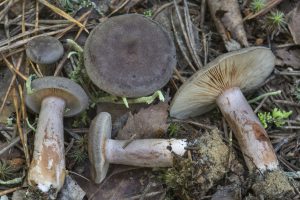 Quite large, up to 9 cm in diameter. In young specimens, the shape is prostrate, slightly convex. In ripe mushrooms, the cap is flat, with a depression in the center. The thickness is small, but the flesh is very fleshy. Its structure is dense and elastic. The edges of the cap at a young age are bent towards the center; in ripe mushrooms, the edges become flat. The main color of the coloration is gray, with a brown, brown, pink or purple tint. The cap is fibrous, but this becomes clearly visible only in ripe mushrooms. During this period, the cap burns out almost to black and the fibers become clearly visible.
Quite large, up to 9 cm in diameter. In young specimens, the shape is prostrate, slightly convex. In ripe mushrooms, the cap is flat, with a depression in the center. The thickness is small, but the flesh is very fleshy. Its structure is dense and elastic. The edges of the cap at a young age are bent towards the center; in ripe mushrooms, the edges become flat. The main color of the coloration is gray, with a brown, brown, pink or purple tint. The cap is fibrous, but this becomes clearly visible only in ripe mushrooms. During this period, the cap burns out almost to black and the fibers become clearly visible.
 Spore-bearing layer
Spore-bearing layer
Lamellar. Its color is off-white, the plates themselves are narrow, often located, adherent to the stem. Spore powder white or grayish, irregularly shaped spores, covered with grooves.
Leg
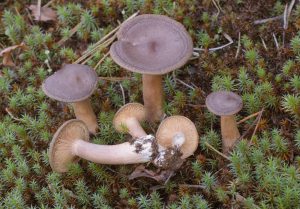 It has a regular cylindrical shape, from 3 to 7 cm long, up to 2 cm in diameter. The structure is dense, elastic, resilient. In young mushrooms, the leg is solid; as it grows and matures, the mushroom becomes hollow. The surface is smooth to the touch, white or grayish in young specimens, dark gray or black in old mushrooms.
It has a regular cylindrical shape, from 3 to 7 cm long, up to 2 cm in diameter. The structure is dense, elastic, resilient. In young mushrooms, the leg is solid; as it grows and matures, the mushroom becomes hollow. The surface is smooth to the touch, white or grayish in young specimens, dark gray or black in old mushrooms.
Pulp
Dense, elastic. Painted white or grayish. At a break or cut, it emits a milky juice that has a sweetish taste with a bitter or pungent aftertaste. However, it is worth remembering that in overripe specimens, milky juice is almost not secreted. In the air, the juice does not change color, it thickens a little.
External description of the mushroom
Mare's Miller (Lactarius mairei) is a classic fruiting body, consisting of a cap and a leg.The fungus is characterized by a lamellar hymenophore, and the plates in it are often located, grow to the stem or descend along it, have a cream color, and are highly branched.
The pulp of the lactician Mayor is characterized by medium density, whitish color, burning aftertaste that appears shortly after eating the mushroom. The milky juice of the mushroom also tastes hot, does not change its color under the influence of air, the aroma of the pulp is similar to that of a fruit.
The cap of the lactarius Mayor is characterized by a curved edge in young mushrooms (it straightens out as the plant reaches maturity), a depressed central part, a smooth and dry surface (although in some mushrooms it may feel like felt). A fluff runs along the edge of the cap, consisting of hairs of small length (up to 5 mm), resembling needles or thorns. The color of the cap varies from light cream to clay-cream, and spherical areas emanate from the central part, painted in a pinkish or saturated clay. Such shades reach about half the diameter of the cap, the size of which is 2.5-12 cm.
The length of the stem of the mushroom is 1.5-4 cm, and the thickness varies within 0.6-1.5 cm. The shape of the stem resembles a cylinder, and to the touch it is smooth, dry, and does not have the slightest dent on the surface. In immature mushrooms, the leg is filled inside, and as it ripens, it becomes empty. It is characterized by pink-cream, cream-yellow or cream color.
Fungal spores are ellipsoidal or spherical, with ridged areas visible. The spore sizes are 5.9-9.0 * 4.8-7.0 microns. The color of the spores is predominantly cream.

